Unsteady Natural Convection in a Cylindrical Containment Vessel (CIGMA) With External Wall Cooling: Numerical CFD Simulation
Abstract
:1. Introduction
2. Experimental Apparatus (CIGMA) and Procedure
2.1. CIGMA Facility
2.2. Natural Convection in the CIGMA Containment Vessel (CC-PL-26B)
3. CFD Modeling and Numerical Approach
3.1. 3-D containment Vessel (CIGMA): Geometry and Mesh
3.2. Governing Equations and Turbulence Models
3.3. Initial and Boundary Conditions
3.3.1. Initial and Boundary Conditions Profile
3.3.2. Boundary Conditions—Conjugate Heat Transfer (CHT)
4. Numerical Procedure and the Computational Mesh
5. Results and Discussions
5.1. The Effect of Grid Resolution
5.2. The Effect of Near-Wall Treatment on Turbulence Model
5.3. The Effect of Buoyancy on the Turbulence Model
- nonCHT_SKO: standard k-ω model without a conjugate heat transfer;
- nonCHT_SSTKO: SST k-ω model without a conjugate heat transfer;
- nonCHT_SKE: standard k-ε model without a conjugate heat transfer; and
- nonCHT_SKE+Gk: standard k-ε model without a conjugate heat transfer + buoyancy production in the turbulent kinetic energy.
5.4. The Effect of the Solid Region (Flat Bars): Conjugate Heat Transfer Model
- CHT_SKE: standard k-ε model with a conjugate heat transfer;
- nonCHT_SKE: standard k-ε model without a conjugate heat transfer;
- CHT_SSTKO: SST k- ω model with a conjugate heat transfer; and
- nonCHT_SSTKO: SST k- ω model without a conjugate heat transfer.
5.5. Temperature Profile
5.6. Contour Plot of Temperature and Velocity
6. Conclusions
- External wall cooling is one of the effective alternative ways to remove heat from the containment vessel and mitigate the pressurization. It was observed in the experiment that the pressure and temperature gradually decrease after the water injection into the upper pool and middle jacket.
- The sensitivity analysis by CFD simulation on the mesh resolution suggested that the cell size of 50 mm × 50 mm was sufficient to model the natural convection test in the large cylindrical containment vessel.
- The implementation of the wall function on the high Reynolds number model showed good agreement with the low Reynolds number model.
- The simulation results employing the SST k-ω turbulence model showed better agreement compared with the standard k-ω and standard k-ε turbulence models. Simulations with the Launder–Sharma and SST k-ω turbulence model showed a similar behavior. Besides, the buoyancy effect on the turbulence model did not show a considerable difference in the results when the density difference was small.
- The accuracy of the heat transfer prediction was improved when the solid internal structure inside the containment vessel, i.e., flat bars, was modeled by conjugate heat transfer. It was revealed that the standard k-ε model was overestimated in the turbulent kinetic. Otherwise, the SST k-ω model had better prediction on the vortex flows, leading to improved wall shear stress and heat transfer predictions.
- The heat transfer rate in the cooled region increased gradually with time after the water was injected into the upper pool and middle jacket. Additionally, it was revealed that the standard k-ε model overestimated the heat transfer rate compared with the SST k-ω model.
Author Contributions
Funding
Acknowledgments
Conflicts of Interest
References
- Raj, V.A.A.; Velraj, R. Review on free cooling of buildings using phase change materials. Renew. Sustain. Energy Rev. 2010, 14, 2819–2829. [Google Scholar] [CrossRef]
- Yeh, L.T. Review of heat transfer technologies in electronic equipment. J. Electron. Pack. Trans. ASME 1995, 117, 333–339. [Google Scholar] [CrossRef]
- Chan, H.Y.; Riffat, S.B.; Zhu, J. Review of passive solar heating and cooling technologies. Renew. Sustain. Energy Rev. 2010, 14, 781–789. [Google Scholar] [CrossRef]
- Zvirin, Y. A review of natural circulation loops in pressurized water reactors and other systems. Nucl. Eng. Des. 1982, 67, 203–225. [Google Scholar] [CrossRef]
- Kim, M.H.; Corradini, M.L. Modeling of condensation heat transfer in a reactor containment. Nucl. Eng. Des. 1990, 118, 193–212. [Google Scholar] [CrossRef]
- Gupta, S. Experimental investigations relevant for hydrogen and fission product issues raised by the Fukushima accident. Nucl. Eng. Technol. 2015, 47, 11–25. [Google Scholar] [CrossRef] [Green Version]
- Gupta, S. Thai test facility for experimental research on hydrogen and fission product behaviour in light water reactor containments. Nucl. Eng. Des. 2015, 294, 183–201. [Google Scholar] [CrossRef]
- Freitag, M.; Schmidt, E.; Gupta, S.; Poss, G. Simulation benchmark based on THAI-experiment on dissolution of a steam stratification by natural convection. Nucl. Eng. Des. 2016, 299, 37–45. [Google Scholar] [CrossRef]
- Stewering, J.; Schramm, B.; Sonnenkalb, M. Validation of CFD-Codes for Natural Convection and Condensation Phenomena in Containments with German Thai-Experiments, Proceedings of the International Topical Meeting on Nuclear Reactor Thermal Hydraulics (NURETH 2015), Pisa, Italy, 12–17 May 2013; American Nuclear Society: Le Grange Park, IL, USA, 2013; pp. 966–978. [Google Scholar]
- OECD/SETH-2 Project PANDA and MISTRA Experiments Final Summary Report—Investigation of Key Issues for the Simulation of Thermal-Hydraulic Conditions in Water Reactor Containments; NEA/CSNI/R(2012)5; Organisation for Economic Co-operation and Development/Nuclear Energy Agency Committee on the Safety of Nuclear Installations: Paris, France, 2012.
- Visser, D.C.; Siccama, N.B.; Jayaraju, S.T.; Komen, E.M.J. Application of a CFD based containment model to different large-scale hydrogen distribution experiments. Nucl. Eng. Des. 2014, 278, 491–502. [Google Scholar] [CrossRef]
- Zajec, B.; Kljenak, I. Simulation of Natural Circulation Experiment in MISTRA Experimental Containment with OpenFOAM CFD Code. In Proceedings of the International Conference Nuclear Energy for New Europe, Portoroz, Slovenia, 9–12 September 2016; pp. 807.1–807.10. [Google Scholar]
- Visser, D.C.; Houkema, M.; Siccama, N.B.; Komen, E.M.J. Validation of a FLUENT CFD model for hydrogen distribution in a containment. Nucl. Eng. Des. 2012, 245, 161–171. [Google Scholar] [CrossRef] [Green Version]
- Robb, K.R. External Cooling of the BWR Mark I and II Drywell Head as a Potential Accident Mitigation Measure–Expanded Scoping Assessment; Oak Ridge National Lab. (ORNL): Oak Ridge, TN, USA, 2018. [Google Scholar] [CrossRef]
- Gui, M.; Wang, J.; Dailey, R.; Corradini, M.L. Performance Analysis of External Drywell Cooling on BWR Mark II Drywell Head Cavity During a Short-Term Station Blackout Scenario by MELCOR, Proceedings of the International Topical Meeting on Nuclear Reactor Thermal Hydraulics (NURETH 2019), Portland, OR, USA, August 2019; American Nuclear Society: Le Grange Park, IL, USA, 2019; pp. 6418–6429. [Google Scholar]
- Yonomoto, T. Thermal Hydraulic Safety Research at JAEA after the Fukushima Dai-Ichi Nuclear Power station accident. In Proceedings of the International Topical Meeting on Nuclear Reactor Thermal Hydraulics (NURETH 2015), Pisa, Italy, 12–17 May 2013; American Nuclear Society: Le Grange Park, IL, USA, 2013; pp. 5341–5352. [Google Scholar]
- Sibamoto, Y.; Ishigaki, M.; Abe, S.; Yonomoto, T. Experimental Study on Outer Surface Cooling of Containment Vessel by Using CIGMA. In Proceedings of the International Topical Meeting on Nuclear Reactor Thermal Hydraulics (NURETH 2017), Xi’an, China, 3–8 September 2017; American Nuclear Society: Le Grange Park, IL, USA, 2017; pp. 1–14. [Google Scholar]
- Ishigaki, M.; Abe, S.; Sibamoto, Y.; Yonomoto, T. Experiments on Collapse of Density Stratification by Outer Surface Cooling of Containment Vessel: CC-PL-12 and CC-PL-24 Experiments at CIGMA. In Proceedings of the International Topical Meeting on Nuclear Reactor Thermal-Hydraulics, Operation and Safety (NUTHOS-12), Qingdao, China, 14–18 October 2018; pp. 1–11. [Google Scholar]
- Sibamoto, Y.; Abe, S.; Ishigaki, M.; Yonomoto, T. First Experiments at the CIGMA Facility for Investigations of LWR Containment Thermal Hydraulics. In Proceedings of the International Conference on Nuclear Engineering (ICONE24), Charlotte, NC, USA, 26–30 June 2016; pp. 1–9. [Google Scholar] [CrossRef]
- Hamdani, A.; Abe, S.; Ishigaki, M.; Sibamoto, Y.; Yonomoto, T. CFD Analysis of the CIGMA Experiments on the Heated Jet Injection into Containment Vessel with External Surface Cooling. In Proceedings of the International Topical Meeting on Nuclear Reactor Thermal Hydraulics (NURETH 2019), Portland, OR, USA, 18–23 August 2019; American Nuclear Society: Le Grange Park, IL, USA, 2019; pp. 5463–5479. [Google Scholar]
- Bradley, D.; Matthews, K.J. Measurement of high gas temperatures with fine wire thermocouples. J. Mech. Eng. Sci. 1968, 10, 299–305. [Google Scholar] [CrossRef]
- Hindasageri, V.; Vedula, R.P.; Prabhu, S.V. Thermocouple error correction for measuring the flame temperature with determination of emissivity and heat transfer coefficient. Rev. Sci. Instrum. 2013, 84, 024902. [Google Scholar] [CrossRef] [PubMed]
- Jones, W.P.; Launder, B.E. The prediction of laminarization with a two-equation model of turbulence. Int. J. Heat Mass Transf. 1972, 15, 301–314. [Google Scholar] [CrossRef]
- Wilcox, D.C. Turbulence Modeling for CFD.; DCW Industries Inc.: Palm Dr La Canada, CA, USA, 1998. [Google Scholar]
- Menter, F.R. Two-equation eddy-viscosity turbulence models for engineering applications. AIAA J. 1994, 32, 1598–1605. [Google Scholar] [CrossRef] [Green Version]
- Launder, B.E.; Sharma, B.I. Application of the energy-dissipation model of turbulence to the calculation of flow near a spinning disc. Lett. Heat Mass Transf. 1974, 1, 131–137. [Google Scholar] [CrossRef]
- Menter, F.R. Review of the shear-stress transport turbulence model experience from an industrial perspective. Int. J. Comput. Fluid Dyn. 2009, 23, 305–316. [Google Scholar] [CrossRef]
- Henkes, R.A.W.M.; van Der Vlugt, F.F.; Hoogendoorn, C.J. Natural-convection flow in a square cavity calculated with low-Reynolds-number turbulence models. Int. J. Heat and Mass Transf. 1991, 34, 377–388. [Google Scholar] [CrossRef]
- Kelm, S.; Müller, H.; Allelein, H.J. A Review of the CFD Modeling Progress Triggered by ISP-47 on Containment Thermal Hydraulics. Nucl. Sci. Eng. 2019, 193, 63–80. [Google Scholar] [CrossRef]
- Abe, S.; Ishigaki, M.; Sibamoto, Y.; Yonomoto, T. RANS analyses on erosion behavior of density stratification consisted of helium–air mixture gas by a low momentum vertical buoyant jet in the PANDA test facility, the third international benchmark exercise (IBE-3). Nucl. Eng. Des. 2015, 289, 231–239. [Google Scholar] [CrossRef]
- Craft, T.J.; Graham, L.J.W.; Launder, B.E. Impinging jet studies for turbulence model assessment-II. An examination of the performance of four turbulence models. Int. J. Heat Mass Transf. 1993, 36, 2685–2697. [Google Scholar] [CrossRef]
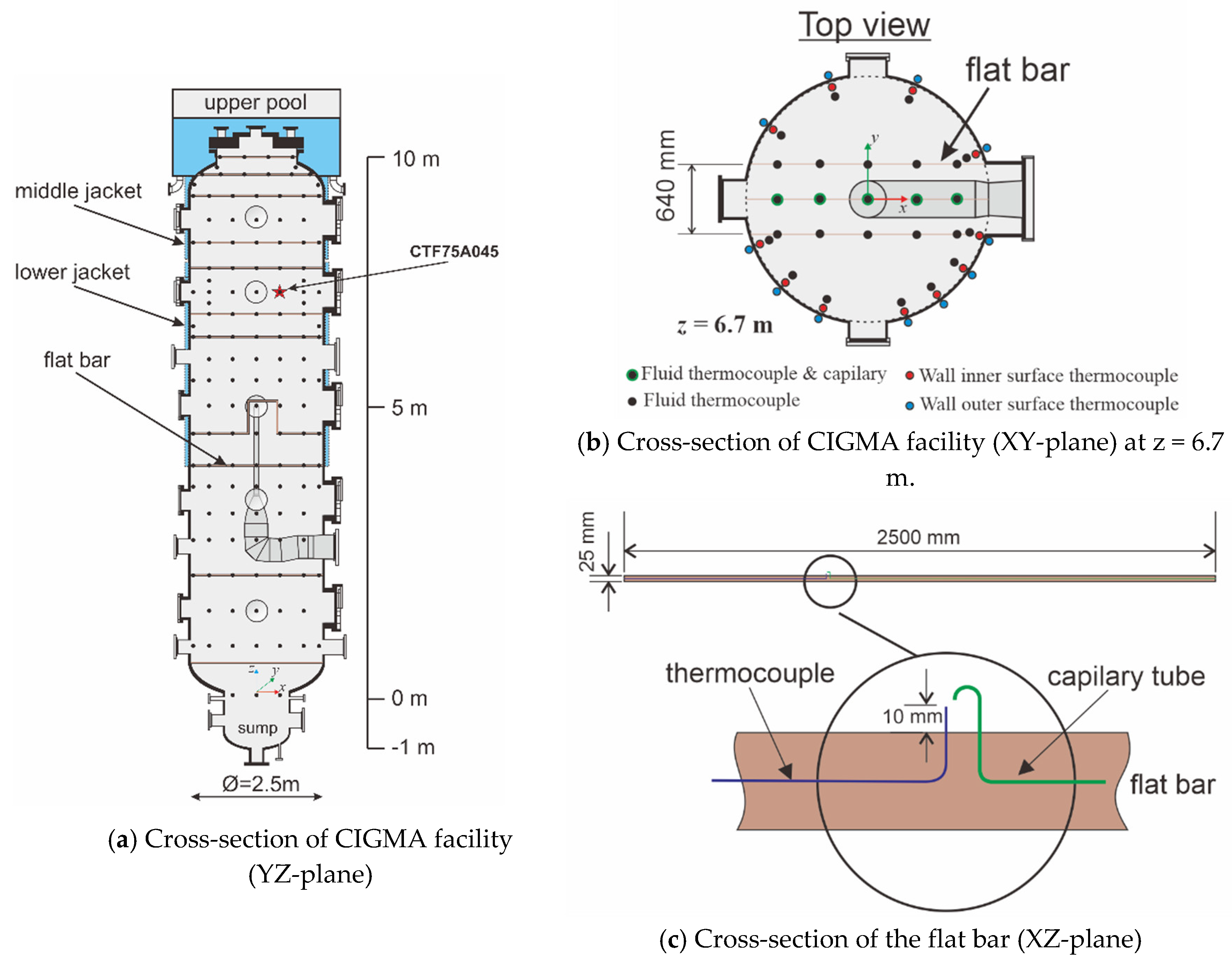
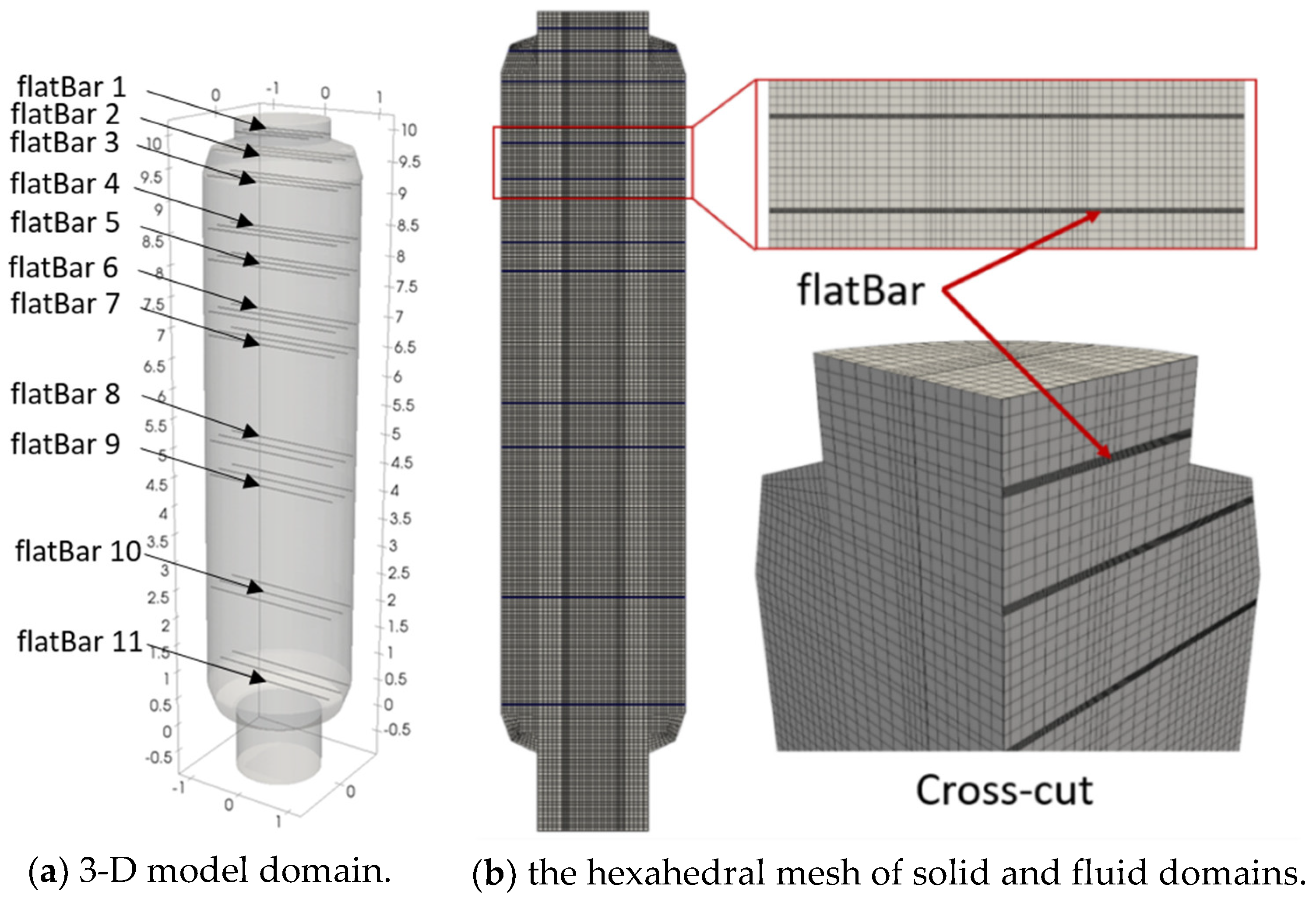
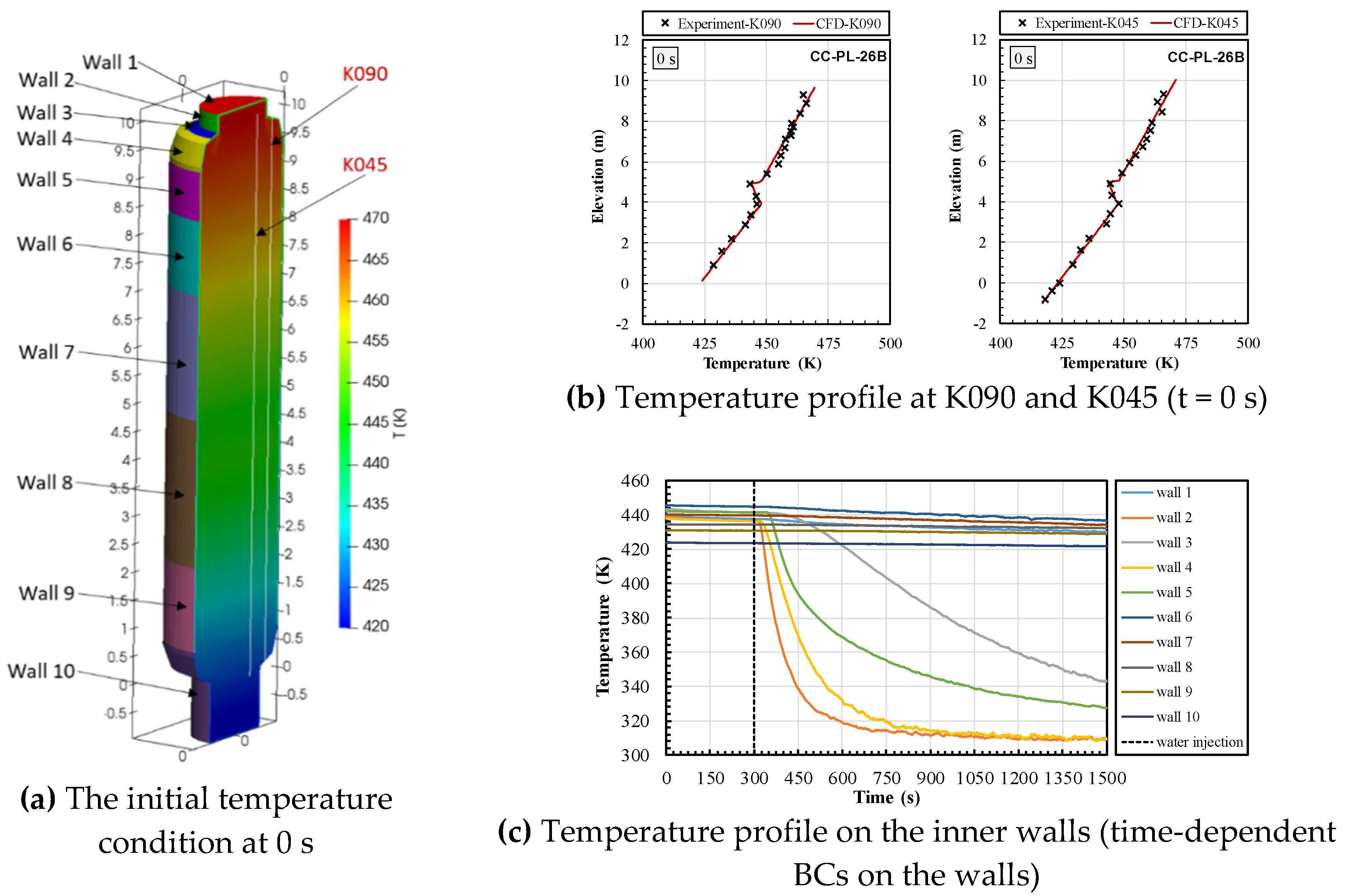


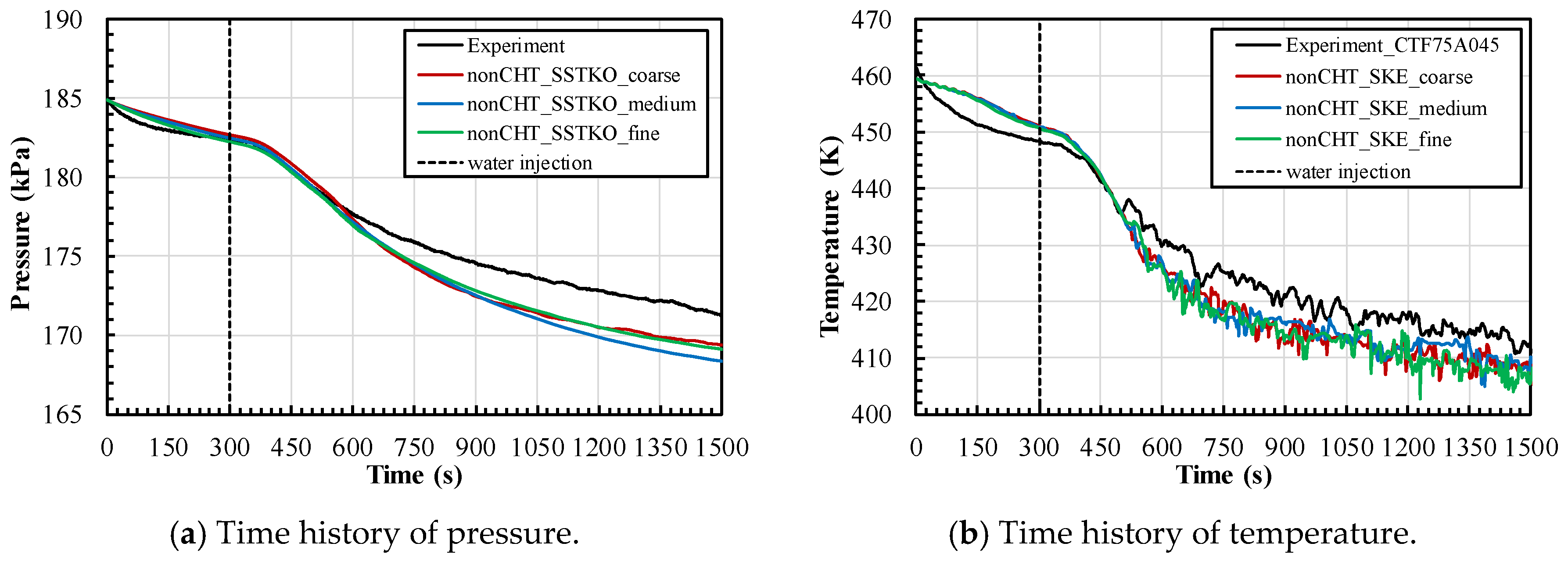




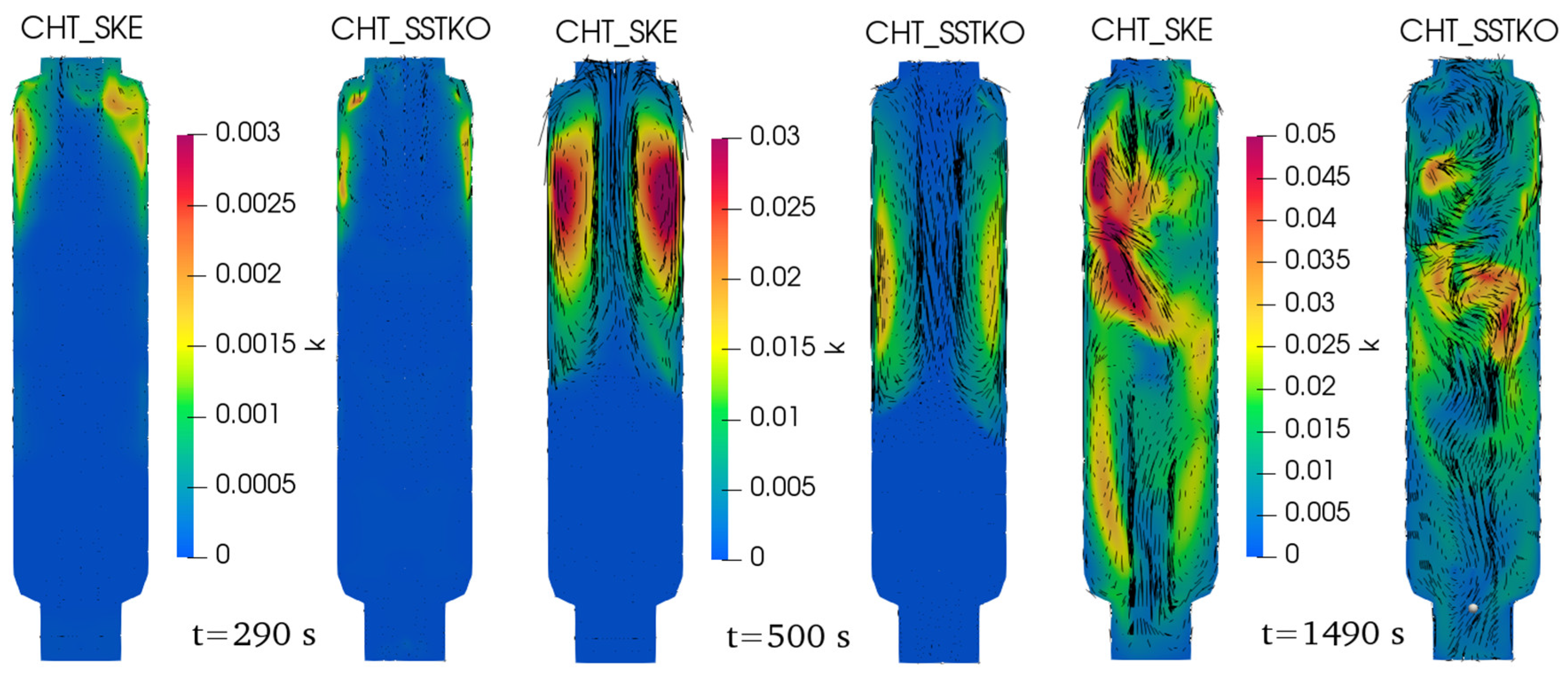

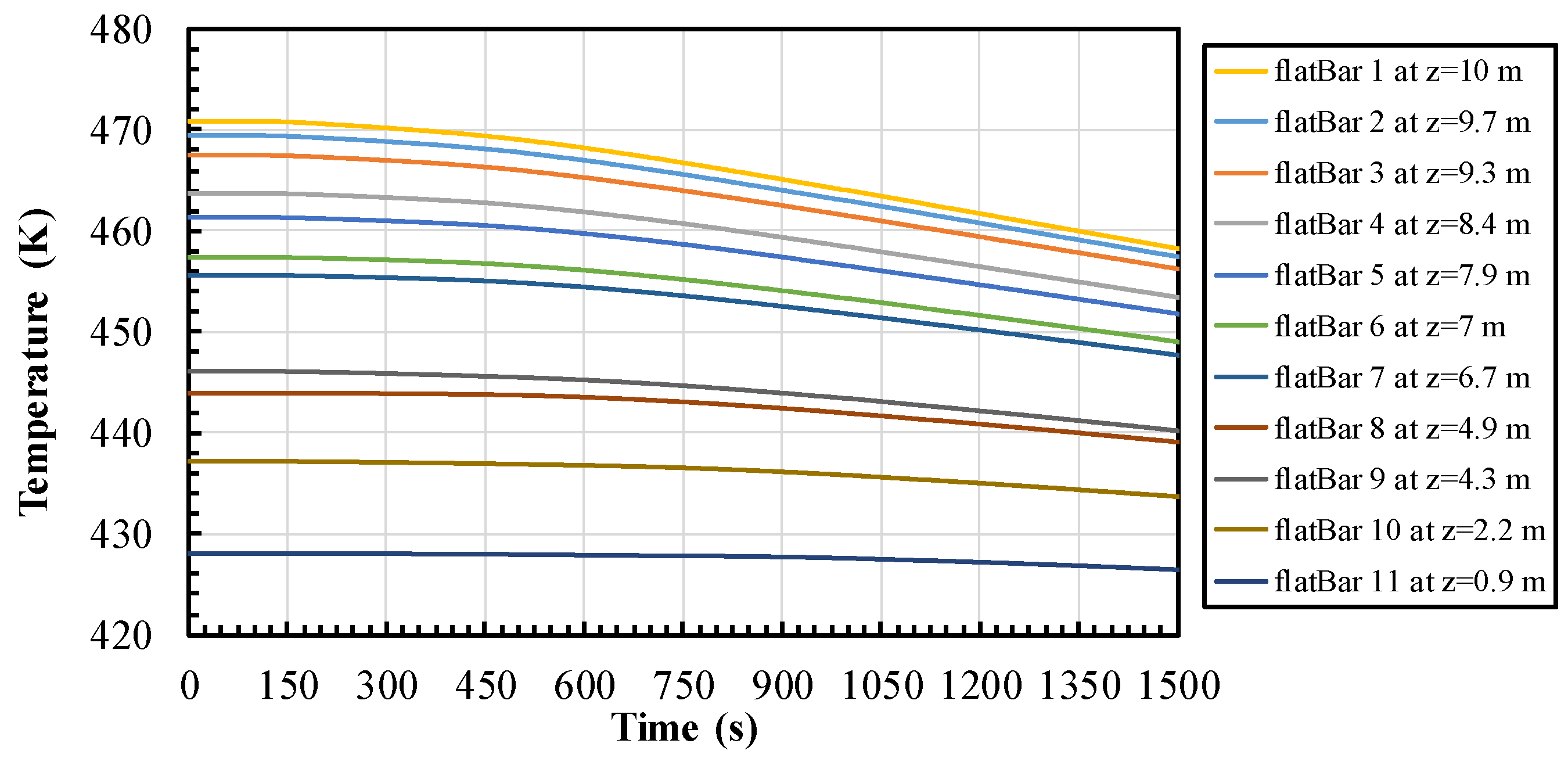
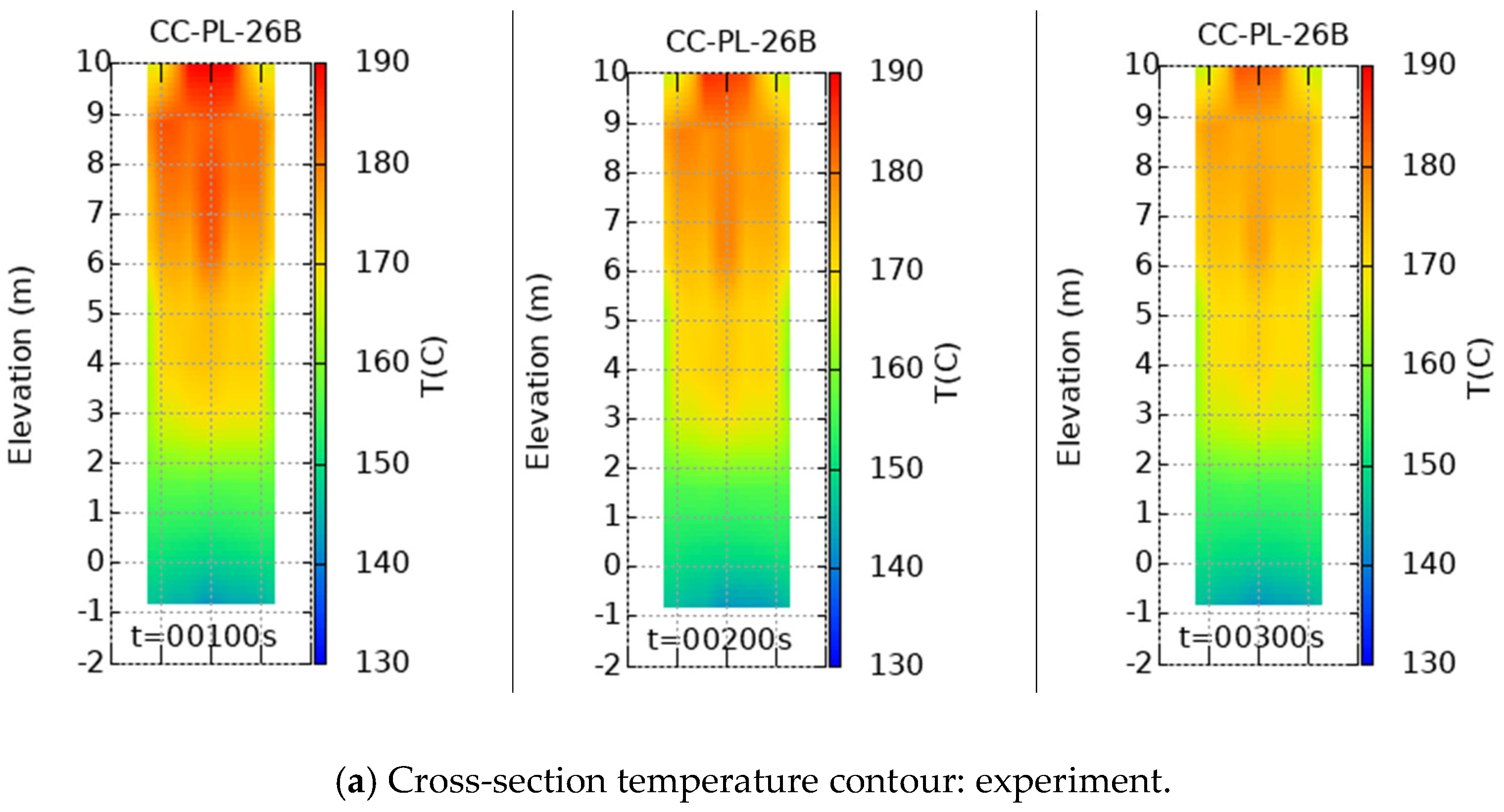
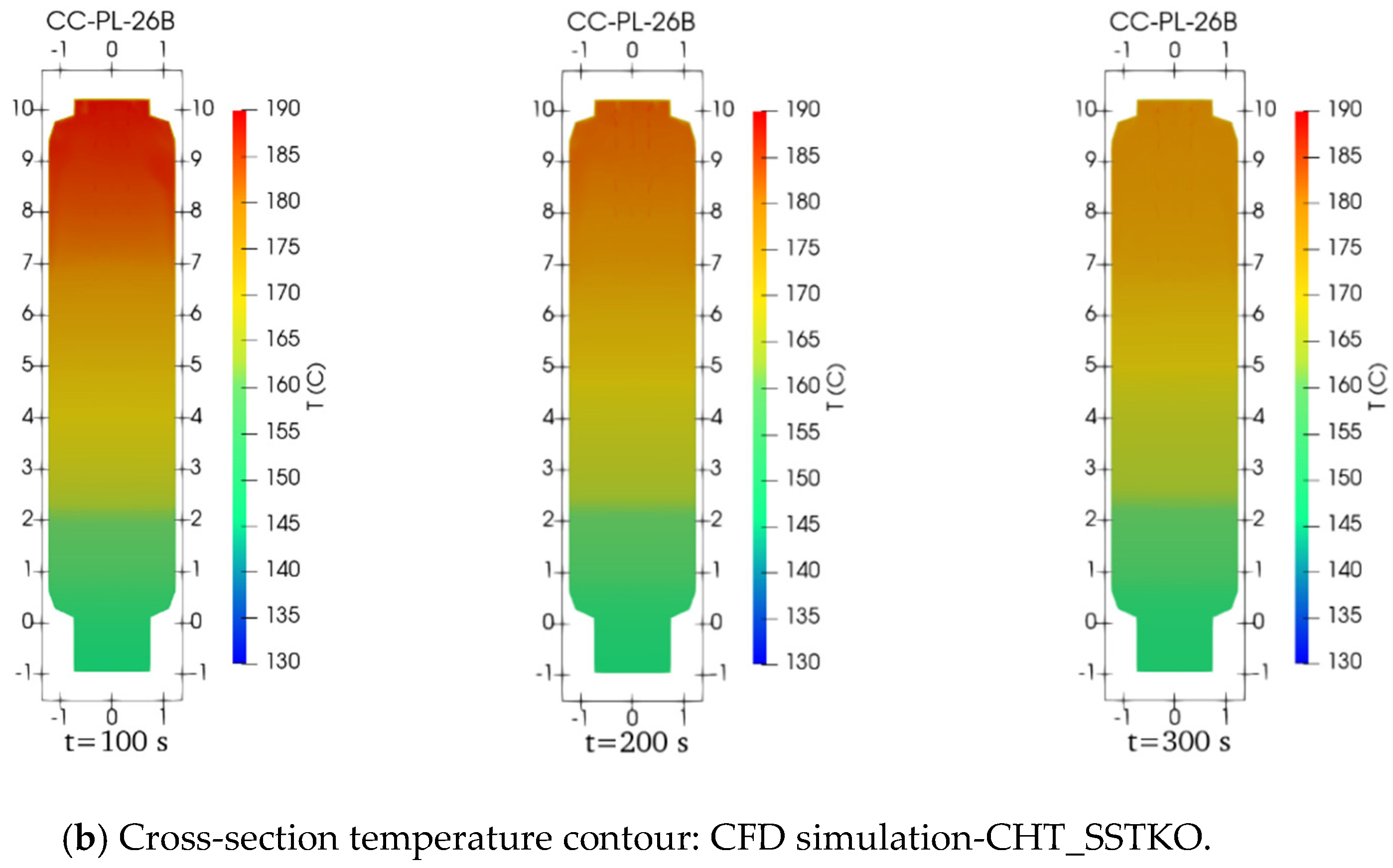

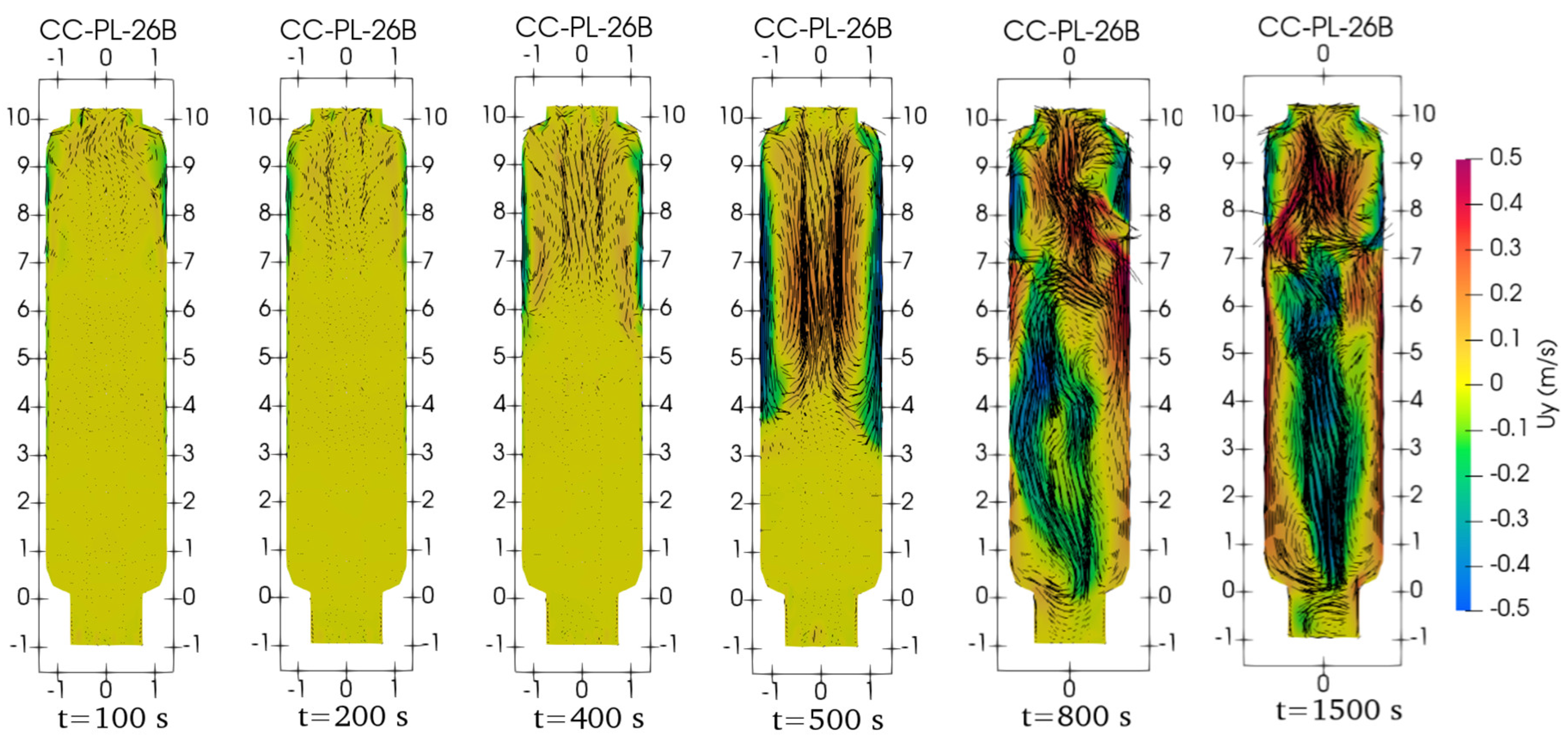
| Parameter | Run ID: CC-PL-26B | |
|---|---|---|
| Average air temperature inside the vessel | T (K) | 450 |
| Average air pressure inside the vessel | P (kPa) | 185 |
| Cooling region | - | upper pool, middle jacket |
| Average water temperature in the upper pool and middle jacket | T (K) | 303 |
| Initiation of water injection into upper pool and middle jacket | t (s) | 300 |
| Timespan of the experiment | t (s) | 4000 |
| Run ID: CC-PL-26B | ||
|---|---|---|
| Boundary Name | Boundary Condition CHT Model | Boundary Condition Non-CHT Model |
| Fluid Region | ||
| Wall | u = 0, T = Dirichlet (time dependent) | u = 0, T = Dirichlet (time dependent) |
| Fluid to solid interface | , | none |
| Solid region | ||
| Flat bar ends | none | |
| Solid to fluid interface | , | none |
| Parameter | Coarse Grid | Medium Grid | Fine Grid | y + = 1 Grid |
|---|---|---|---|---|
| Number of cells | 112,112 | 373,120 | 1,026,317 | 1,847,600 |
| Mean cells size in the bulk region (radial direction) | 75 mm | 50 mm | 35 mm | 45 mm |
| Mean cells size in the bulk region (vertical direction) | 75 mm | 50 mm | 35 mm | 50 mm |
| First cell size | 60 mm | 50 mm | 40 mm | 0.5 mm |
| Mean wall-adjacent cell y+ | 50 | 50 | 50 | <1 |
| Near-wall treatment | Standard wall function | Standard wall function | Standard wall function | resolved |
| Method | Model | t = 250 s Probe: CTF75A045 | t = 750 s Probe: CTF75A045 | t = 1250 s Probe: CTF75A045 | |||
|---|---|---|---|---|---|---|---|
| Pressure (kPa) | Deviation (%) | Pressure (kPa) | Deviation (%) | Pressure (kPa) | Deviation (%) | ||
| Experiment | - | 182.570 | - | 175.88 | - | 172.56 | - |
| CFD Simulation | SKO | 182.787 | 0.12 | 173.539 | 1.33 | 169.830 | 1.58 |
| SSTKO | 182.915 | 0.19 | 174.272 | 0.91 | 170.370 | 1.27 | |
| SKE | 182.831 | 0.14 | 173.506 | 1.35 | 170.267 | 1.33 | |
| SKE+Gk | 182.508 | 0.03 | 172.924 | 1.68 | 169.860 | 1.56 | |
| Method | Model | t = 1500 s Probe: CTF75A045 | t = 1500 s Probe: CTF75A045 | ||
|---|---|---|---|---|---|
| Temperature (K) | Deviation (%) | Pressure (kPa) | Deviation (%) | ||
| Experiment | 411.260 | 171.270 | |||
| CFD simulation | nonCHT_SKE | 410.140 | 0.27 | 169.354 | 1.18 |
| CHT_SKE | 408.298 | 0.72 | 170.150 | 0.65 | |
| nonCHT_SSTKO | 408.511 | 0.67 | 169.090 | 1.27 | |
| CHT_SSTKO | 410.569 | 0.17 | 170.286 | 0.57 | |
| Model | Computation Times (hour) |
|---|---|
| CHT_SKE | 6.96 |
| nonCHT_SKE | 4.12 |
| CHT_SSTKO | 5.58 |
| nonCHT_SSTKO | 3.51 |
© 2020 by the authors. Licensee MDPI, Basel, Switzerland. This article is an open access article distributed under the terms and conditions of the Creative Commons Attribution (CC BY) license (http://creativecommons.org/licenses/by/4.0/).
Share and Cite
Hamdani, A.; Abe, S.; Ishigaki, M.; Sibamoto, Y.; Yonomoto, T. Unsteady Natural Convection in a Cylindrical Containment Vessel (CIGMA) With External Wall Cooling: Numerical CFD Simulation. Energies 2020, 13, 3652. https://doi.org/10.3390/en13143652
Hamdani A, Abe S, Ishigaki M, Sibamoto Y, Yonomoto T. Unsteady Natural Convection in a Cylindrical Containment Vessel (CIGMA) With External Wall Cooling: Numerical CFD Simulation. Energies. 2020; 13(14):3652. https://doi.org/10.3390/en13143652
Chicago/Turabian StyleHamdani, Ari, Satoshi Abe, Masahiro Ishigaki, Yasuteru Sibamoto, and Taisuke Yonomoto. 2020. "Unsteady Natural Convection in a Cylindrical Containment Vessel (CIGMA) With External Wall Cooling: Numerical CFD Simulation" Energies 13, no. 14: 3652. https://doi.org/10.3390/en13143652







